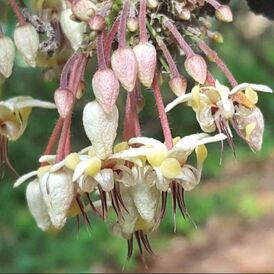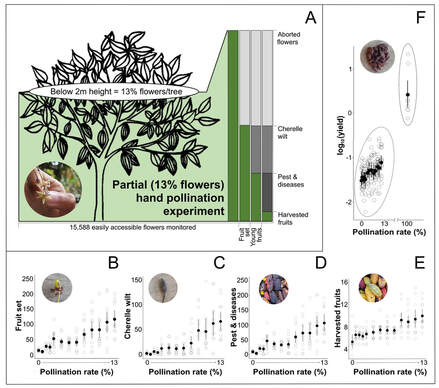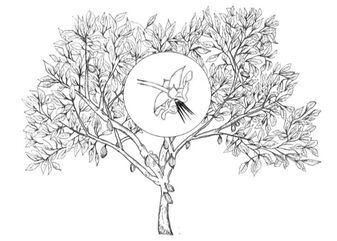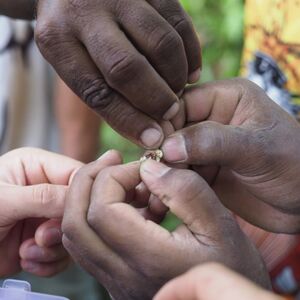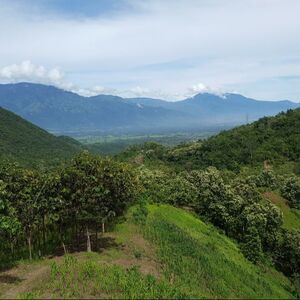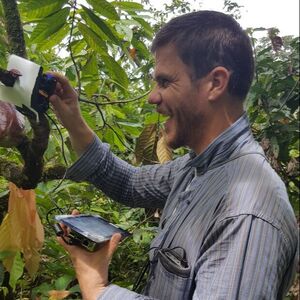Cocoa Pollination
|
The cocoa tree (Theobroma cacao L.), a major traded commodity globally, strongly depends on insect pollinators for fruit production (1,2). But there are major knowledge gaps on the pollination ecology of cocoa and its contribution for increasing yields sustainably. This is relevant as stakeholders face the challenge of boosting production without further forest conversion.
As we know that around 5% of flowers are naturally pollinated, and from this proportion less than 10% develop to harvestable fruits (3), the main question arising is: to what level can enhancing pollination services in cocoa help meeting this challenge? |
The case of Central Sulawesi, Indonesia
|
During my PhD studies, I wanted to contribute in closing the knowledge gaps in cocoa pollination. The main findings of my work in Indonesia can be summarized as follow:
|
Cross-Continental Cocoa Pollination
|
The Cross-Continental Cocoa Pollination project was developed with the support of international scientists conducting long-term research in cocoa agroforests in the main producing regions of South America, West Africa, and South East Asia.
This project uses the studies carried out in Indonesia as baseline, with the addition of innovative sampling techniques and ideas, to understand the contribution of cocoa pollination at a global level. Current field work covers countries such Brazil, Ghana, Cameroon and Indonesia. |
Main research areas
|
The contribution of hand pollinations to increase yields
|
Landscape and farm management effect on pollinator communities
|
Innovative techniques to monitor insect pollinators
|
References
(1) Donald, P. F. (2004). Biodiversity impacts of some agricultural commodity production systems. Conservation biology, 18(1), 17-37.
(2) Tscharntke, T., Clough, Y., Bhagwat, S. A., Buchori, D., Faust, H., Hertel, D., ... & Scherber, C. (2011). Multifunctional shade‐tree management in tropical agroforestry landscapes–a review. Journal of Applied Ecology, 48(3), 619-629.
(3) Toledo-Hernández, M., Wanger, T. C., & Tscharntke, T. (2017). Neglected pollinators: Can enhanced pollination services improve cocoa yields? A review. Agriculture, ecosystems & environment, 247, 137-148.
(4) Toledo-Hernández, M., Tscharntke, T., Tjoa, A., Anshary, A., Cyio, B., & Wanger, T. C. (2020). Hand pollination, not pesticides or fertilizers, increases cocoa yields and farmer income. Agriculture, Ecosystems & Environment, 304, 107160.
(1) Donald, P. F. (2004). Biodiversity impacts of some agricultural commodity production systems. Conservation biology, 18(1), 17-37.
(2) Tscharntke, T., Clough, Y., Bhagwat, S. A., Buchori, D., Faust, H., Hertel, D., ... & Scherber, C. (2011). Multifunctional shade‐tree management in tropical agroforestry landscapes–a review. Journal of Applied Ecology, 48(3), 619-629.
(3) Toledo-Hernández, M., Wanger, T. C., & Tscharntke, T. (2017). Neglected pollinators: Can enhanced pollination services improve cocoa yields? A review. Agriculture, ecosystems & environment, 247, 137-148.
(4) Toledo-Hernández, M., Tscharntke, T., Tjoa, A., Anshary, A., Cyio, B., & Wanger, T. C. (2020). Hand pollination, not pesticides or fertilizers, increases cocoa yields and farmer income. Agriculture, Ecosystems & Environment, 304, 107160.
